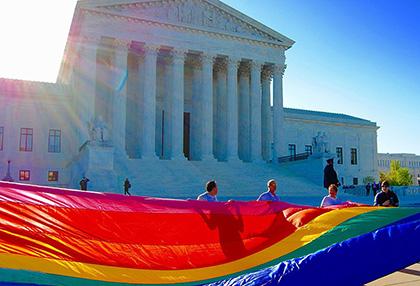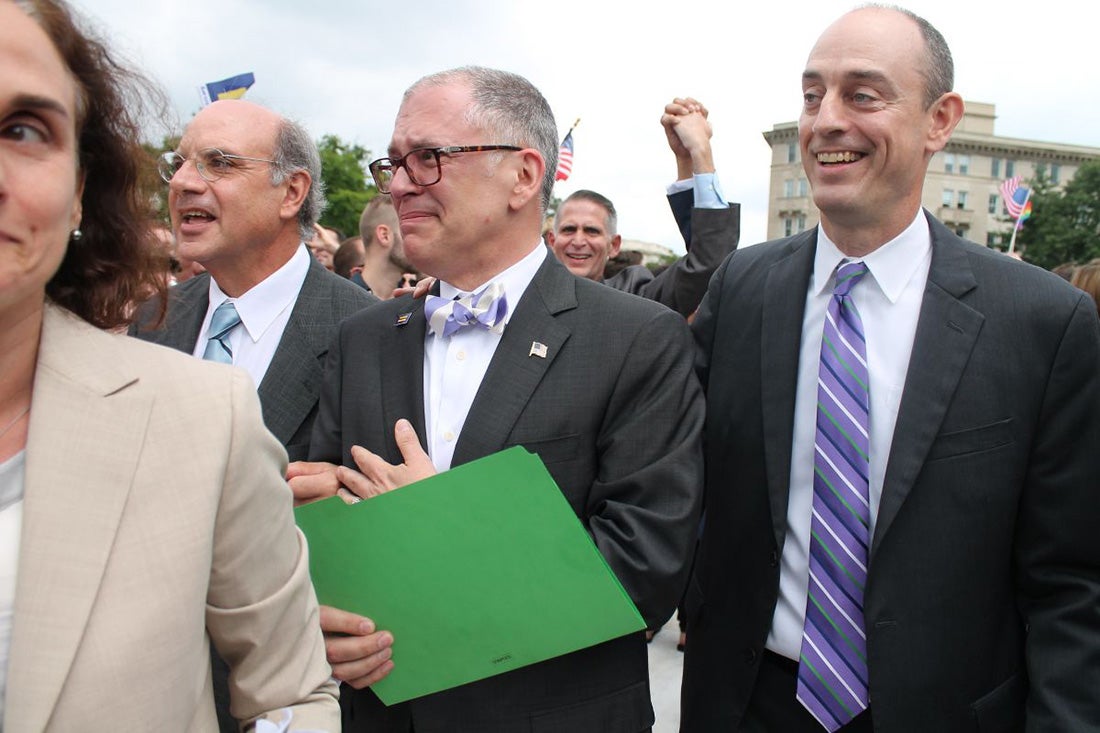A decade after the Supreme Court’s Obergefell decision, marriage equality endures risky terrain
Same-sex marriage has boomed, but LGBTQ rights and protections are under threat of being taken away

Milestones — especially in decades — usually call for celebration. The 10th anniversary of Obergefell v. Hodges, the Supreme Court case that made same-sex marriage legal nationwide, is different. There’s a sense of unease as state and federal lawmakers, as well as several judges, take steps that could bring the issue back to the Supreme Court, which could undermine or overturn existing and future same-sex marriages and weaken additional anti-discrimination protections.
In its nearly quarter century of existence, the Williams Institute at UCLA School of Law has been on the front lines of LGBTQ rights. Its amicus brief in the Obergefell case was instrumental, with Justice Anthony Kennedy citing data from the institute on the number of same-sex couples raising children as a deciding factor in the landmark decision.
“There were claims that allowing same-sex couples to marry would somehow devalue or diminish marriage for everyone, including different-sex couples,” said Brad Sears, a distinguished senior scholar of law and policy at the Williams Institute. “We found no indication of that. The national conversation around marriage may have actually revitalized marriage overall.”
Studies from Sears, who is the Williams Institute’s founding executive director, and other institute researchers show same-sex marriage thriving. A recently released study from the Williams Institute found that the number of married same-sex couples has more than doubled since the Obergefell decision. In the 2024 study “Perspectives on Marriage Equality,” the vast majority of married same-sex couples surveyed reported that marriage improved their sense of security and resulted in greater life satisfaction and a closer relationship with their spouse.

Additionally, the positive impacts of their nuptials on an economic level were significant: an estimated $5.9 billion for state and local economies and $432.2 million in state and local tax revenue.
Thanks to years of work by LGBTQ organizations, positive public opinion around marriage equality and LGBTQ rights in general continues to be strong in the U.S.
“The incredible amount of social support that LGBTQ communities have built over the past few decades remains, as well as legal protections in many states that did not exist even a few years ago,” Sears said.
Still, in the current political climate, the majority of married same-sex couples surveyed by the institute worry about the future of marriage equality and its possible return to the Supreme Court. If overturned, there are currently 31 states, according to a report released earlier this month by the institute, where same-sex couples would be particularly vulnerable because of statutes or constitutional amendments in place that ban marriage equality.
A potential reversal casts shadows on same-sex marriage
Seven years after Obergefell, the Supreme Court overturned Roe v. Wade, rescinding the national right to abortion and raising fears for progressive policies.
In a concurring opinion, Justice Clarence Thomas explicitly called for the Court to revisit Obergefell. Justice Samuel Alito has echoed those sentiments, tacitly inviting legal challenges.
Despite the direction of the Supreme Court, Sears argues that Obergefell is not on the same legal footing as Roe v. Wade.
“There are significant differences between marriage equality and abortion,” he said. “Obergefell rests on both the due process clause and the equal protection clause. Roe was based squarely in privacy rights under due process. There's room for the court to say, ‘This is different.’”
Another key distinction is the legal concept of reliance, which in part acknowledges contractual agreements. Marriage, Sears says, is deeply embedded in legal, financial and familial systems.
“People start living together in anticipation that one day they will get married,” he said. “They start commingling resources. Eventually, they have a wedding. Often, people's families and friends help contribute to the wedding, and there are a lot of people relying on the fact that they are getting married. So this extension of reliance extends far beyond the couple.”
Although support has dipped slightly in recent years among subsets of the population, public opinion polls have shown enduring majority support for same-sex marriage.
“The backlash against same-sex marriage created a national discussion, and then it became a political possibility,” Sears said. “Visibility increased, and our rights increased. I’m hoping we’re on the same trajectory for transgender people.”
While Sears believes the legal arguments in favor of Obergefell are strong, he adds a note of caution.
“We still have this Supreme Court,” he said. “That doesn’t mean they’ll necessarily pay attention to the strength of these arguments.”
The future of anti-discrimination policies
Last year, at President Donald Trump’s urging, the GOP’s 2024 platform removed language condemning same-sex marriage, and only devoted a few sentences to the subject. While some saw this as progress in solidfying federal civil rights protections for LGBTQ people, Sears and others see complexity, especially as recent data has shown increased support among Republicans for restrictive bathroom bills.
“There are still those who are very committed to a faith-based morality that excludes LGBTQ people, and we’re seeing that play out with ferocious anti-transgender policies,” Sears said. “There are those who don’t believe transgender people exist, and they’re trying to enforce that.”
Williams Institute research shows an estimated 1.6 million people ages 13 and older in the U.S. identify as transgender.
The current administration has issued executive orders banning trans women from women’s sports, excluding transgender people in the military and an order stating that the U.S. recognizes only two sexes.
“There's a lot of negative policy being developed toward LGBTQ people in the country today, and it's easy to get discouraged by that,” Sears said. “Still, LGBTQ communities have survived some difficult times, and many courts are demonstrating that there is still a role for research and the rule of law.”
More recently, the Supreme Court upheld Tennessee’s law banning access to gender-affirming care for transgender youth.
The decision impacts the 112,400 transgender youth ages 13-17 who live in Tennessee and 24 other states that have similar laws banning access to gender-affirming care for transgender youth.
Those in need of care could travel to states that still offer access, creating a patchwork system not dissimilar to same-sex couples seeking marriage prior to Obergefell.
Obergefell passes its milestone in an atmosphere of uncertainty, under intermittent threat along with other rights for LGBTQ communities, but Sears and his team press on with the institute’s mission.
“The role of the Williams Institute is to continue to do research so that laws and polices reflect the realities of LGBTQ people’s daily lives, not the assertions and myths that are made up about them.”